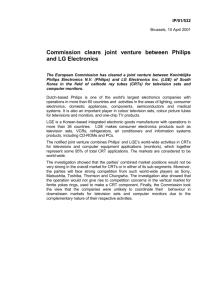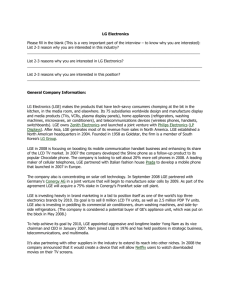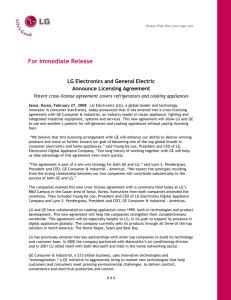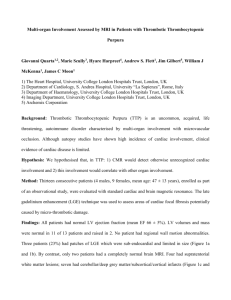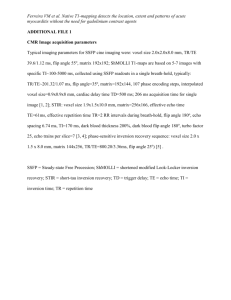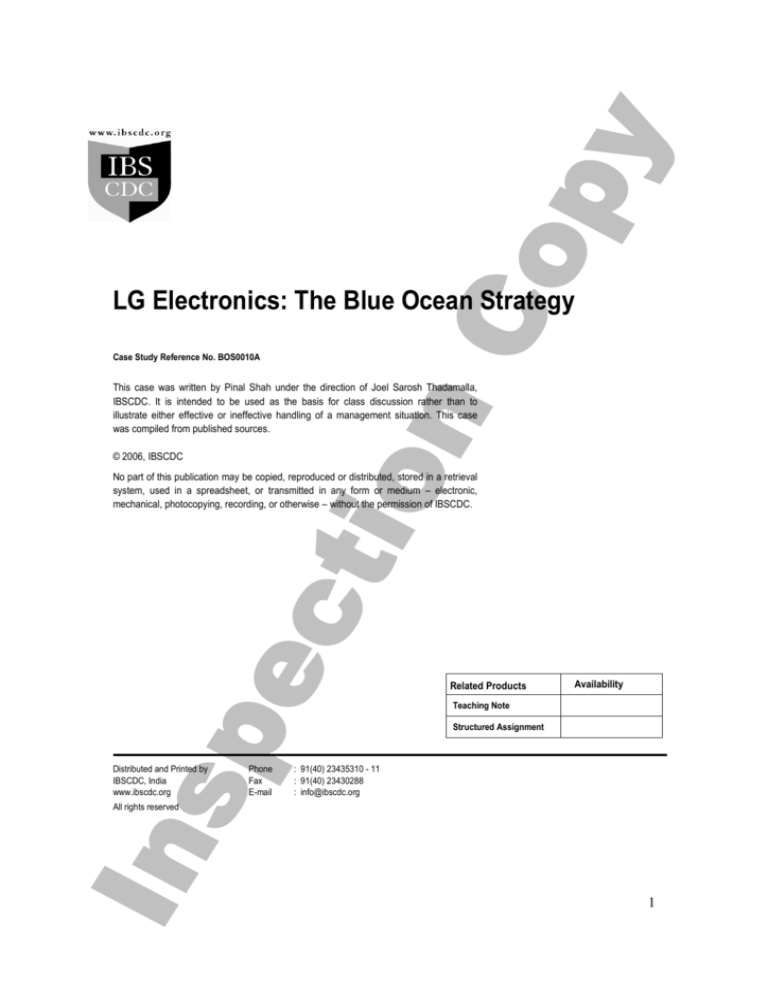
Co
py
LG Electronics: The Blue Ocean Strategy
Case Study Reference No. BOS0010A
n
This case was written by Pinal Shah under the direction of Joel Sarosh Thadamalla,
IBSCDC. It is intended to be used as the basis for class discussion rather than to
illustrate either effective or ineffective handling of a management situation. This case
was compiled from published sources.
ec
tio
© 2006, IBSCDC
sp
No part of this publication may be copied, reproduced or distributed, stored in a retrieval
system, used in a spreadsheet, or transmitted in any form or medium – electronic,
mechanical, photocopying, recording, or otherwise – without the permission of IBSCDC.
Distributed and Printed by
IBSCDC, India
www.ibscdc.org
Phone
Fax
E-mail
Related Products
Availability
Teaching Note
Structured Assignment
: 91(40) 23435310 - 11
: 91(40) 23430288
: info@ibscdc.org
In
All rights reserved
1
Co
py
LG Electronics: The Blue Ocean Strategy
“A company is not only top management, nor is it only middle management. A company is
everyone from the top to the front lines. And it is only when all the members of an organization
are aligned around a strategy and support it, for better or for worse that a company stands apart
as a great and consistent executor. Overcoming the organizational hurdles to strategy execution
is an important step toward that end. It removes the roadblocks that can put a halt to even the
best of strategies1.”
LG Electronics, Inc. (LGE) was primarily known for its low-cost appliances had more than
72,000 employees working in about 77 subsidiaries and marketing units across the world.
Youngdungpo-gu, South Korea based LGE was a technology innovator in electronics,
information and communications businesses producing CDMA2 handsets, DVD3 players, optical
storage devices, canister vacuum cleaners, air conditioners micro ovens and consumer electronics.
LGE comprised four SBUs4: Mobile Communications, Digital Appliance, Digital Display and
Digital Media with total revenue of more than US$ 35 billion (consolidated US$ 45 billion)5.
ec
tio
n
LGE embraced the philosophy of “Great Company, Great People,” and pursued two growth
strategies which involved “fast innovation” and “fast growth” to secure global competitiveness.
The company sought to secure three core capabilities – product leadership, market leadership, and
people-centered leadership. (Exhibit I) Since 1993, LGE had been undertaking ‘Super A’6
pioneering activities, to strengthen its competitiveness and create profitability. In 2003, LGE
repositioned itself as a leading global consumer electronics brand.7 The company also practiced
TL 20058, a technological management strategy to build and sustain prominence in the global
marketplace.9
In addition, to achieve an ideal management base, LGE was carrying out the Six Sigma
Campaign. In January 2006, the company launched “Blue Ocean10 Management” campaign11 to
be one among the top 3 EIT 12 firms in the world by 2010. 13
Further, LGE planned to double its sales volume, profit and shareholder benefit with
30% of its sales volume and 50% of its profit derived from blue ocean products. 14
1
W Chan Kim, Renee Mauborgne, “Blue Ocean Strategy,” Harvard Business Press, 2005, Page 171
Code Division Multiple Access
Digital Video Device
4
Strategic Business Units
5
Overview, http://www.lge.com/about/corporate/company_overview.jsp
6
Super A- It was the activities performed in order to achieve profitability and competences.
7
“LG Electronics lights up time squre”, http://www.ogilvypr.com/case-studies/lg-electronics.cfm
8
TL (Technology Leadership) 2005 - R&D efforts to achieve global technology leadership in selected business areas and
technologies - is the technology management strategy adopted by LGE to position itself as a Global Market Leader
9
“Innovation”, http://www.lge.com/about/corporate/corporateculture_innovation.jsp
10
Blue ocean strategy is about epoch-making move of strengthening business capabilities and streamlining business structure in the
five arenas of products, business model, work, system and human resources.
11
“Press release”, http://www.lg.co.kr/eabout/news/release/read.jsp
12
Electronics, information, and telecommunications
13
“Corporate Information”, http://www.lge.com/about/corporate/company_vision.jsp
14
Jeff Ooi,“When beating competitors simply means making them irrelevant”, April 16, 2006, http://www.jeffooi.com/iwitness/2006/04/blue_ocean_strategy.php,
2
In
sp
3
2
Co
py
Global Consumer Electronics
The consumer electronics industry was very dynamic and ever changing impacting every aspect
of modern life. The demands of the consumers were ever-increasing and the companies were
using state-of-the-art technologies to stay in competition. The electronics sector held great
potential not only for the new-entrants, but also for the existing industry giants. To stay ahead of
competitors, companies constantly moved into new markets emerging around the world. To
succeed in these global markets, consumer electronics companies ensured that their products were
compatible with local infrastructure. User interfaces and embedded software were being
localized, providing documentation and support systems to the needs, language, and culture of
local users at the same time controlling costs and accelerating time-to-market.15
ec
tio
n
The consumer electronics market generated total revenues of $49.7 billion in 2005 with the
growth of 11.9% representing a Compound annual growth rate (CAGR) of 10% for the five-year
period spanning 2001- 200516. Sales from products like plasma and LCD television and other
video segment had generated total revenues of $39.6 billion, equivalent to 79.7% of the market’s
overall value17. (Exhibit II) The increasing popularity of the digital music format like MP3
players, the sale of audio equipment also contributed significant revenues, with total sales of $6.2
billion in 2005, equating to 12.4% of the market’s aggregate revenues.18 The Asia-Pacific region
constituted 31.7% of the in global consumer electronics industry as global revenues with rising
income levels in China and India stimulating consumer spending there.19 In the Asian region
South Korea represented with 9.8% of market share which was small but held an important share
in wireless, Internet services and applications and in the digital market20. (Exhibit III)
Korean industries were dominated by a small number of large, family owned companies called
‘chaebols’, which include the electronics giants LG and Samsung. Such chaebols typically
traversed several industries and were exceptionally vertically-integrated within a given industry.
Through such vertical integration, companies had full control of the supply chain, through which
they could minimize costs and maximize efficiencies accordingly. Through their significant
economies of scale and scope such Korean chaebols had become global household names within
the consumer electronics industry.21
About LG
15
sp
Founded in 1947 as Lucky Chemical Industrial Corporation (LCIC), the company initially
manufactured a cosmetic called Lucky Cream. . In 1952, LCIC became the first Korean company
to enter the plastics industry to make cosmetics containers lids. As LCIC expanded its plastics
business, it also established an electronic company, GoldStar in 1958.
In
“An
Industry
Insight
to
the
World
Consumer
Electronics,”
February,
2005,
www.theinfoshop.com/study/rnc27487_consumer_electronics.html,
16
“Consumer electronics in United States,” June, 2006, https://210.18.104.227/cgi-bin/nph,
120025.cgi/010110A/http/dbic.datamonitor.com/industries/profile/?pid=5DF2CEF4-F6EA-49C7-BA6D-E4E93F1429C2
17
Ibid
18
Op cit., Ibid
19
Op cit. “Consumer electronics in United States,”
20
“Consumer electronics in Asia pacific”, https://210.18.104.227/cgi-bin/nph
120025.cgi/010110A/http/dbic.datamonitor.com/industries/profile/?pid=BFCD7905-5D0D-4697-9B4A-843385C260B2, June 2006
21
“Consumer electronics in South Korea”, https://210.18.104.227/cgi-bin/nph120025.cgi/010110A/http/dbic.datamonitor.com/industries/profile/?pid=03652D9F-17A5-45F1-A700-015E7C21F7F9, June 2006
3
Co
py
In 1959, GoldStar produced Korea’s first radio which opened a new era for the electronics
industry22 in Korea. (Exhibit IV). Until 1960 the sales volume was just tens of thousands but soon
picked up to 1.34 million units in 1962 and by 1963, GoldStar was exported to the U.S. and Hong
Kong.23 As sales began to improve, the company began to prepare for a more diversified business
management and recruited proven business professionals to lead. It also began to establish mass
production centers. In 1966, GoldStar introduced the first Korean-made black and white TV set.
In 1969, when President Chul-hwui Koo of LCIC was appointed as the second Chairman of
GoldStar, the GoldStar Group underwent a major management restructuring. In the same year,
LCIC went public and GoldStar too followed the suit.
The Korean electronics industry with active support from the Government in the 1970s showed
promising growth. GoldStar established large plants and secured a nationwide production base.
The large plants helped the company to expand and sowed the seeds for globalization. In 1975,
GoldStar established a central R&D centre to develop color TV, VCRs and computers. In 1976,
the company produced the first Korean made color TV.
n
In 1977, GoldStar’s sales were over 100 billion. The export volume in 1978, reached US$ 100
million.24 After this the company laid the foundation for globalizing the Korean electronics
industry.
In the early 1980s, GoldStar pursued profit-oriented operations and opted for a series of
ec
tio
restructuring exercises to combat rising competition and to be effective in its efforts in
globalization program. With the change in international trade scenario, it became essential for the
company to establish overseas manufacturing bases to pursue international markets. GoldStar
established a manufacturing subsidiary in Huntsville,25 U.S. in 1982 and other manufacturing and
sales subsidiaries in Germany. The company established a subsidiary in UK (1988) and a
manufacturing subsidiary in Mexico26 in1989. (Exhibit V)
The energy crisis and political unrest in the early 1980s had a negative effect on GoldStar’s
growth. But the company was able to overcome the situation and by 1984, the total sales were
exceeding 1.2956 trillion. 27 At this point of time GoldStar followed effective business strategies
and focused on product diversification and strengthened its national sales channels in Korea. At
the same time the company also focused on diversification of its export structure in international
sales.
22
sp
In the late 1980s LG had adopted a new strategy focusing on quality of product and expanding
marketing capabilities. When the South Korean government relaxed trade barriers, there was
great penetration of foreign companies entered to compete with domestic firms including LGE.
As a result, sales of LG products dropped by US$ 1 billion and profits deceased by 18% between
1986 and 1987. The company was able to challenge foreign companies by restructuring the
organization and adopting a new management style with decentralized structure.28 From 1992
onwards the company focused on ‘creating value for customers’, highlighting its commitment to
Ibid
http://ca.lge.com/en/experience/story/story_beginning.jsp
“Story of LG”, http://ca.lge.com/en/experience/story/story_beginning.jsp
25
Huntsville was the county seat of Madison County, Alabama in the United States.
26
“LG Electronic Inc”, https://210.18.104.227/cgi-bin/nph120025.cgi/010110A/http/dbic.datamonitor.com/companies/company/?pid=E81333A5-8192-426E-BB11-ED6D09B879EF, LG
electronics Inc.
27
“Story of LG”, http://ca.lge.com/en/experience/story/story_globalization.jsp
28
PR Bhatt, 'Global Strategy for Global Leadership: A Case of LG Electronics' 20 March 2005,
www.bodhini.com/March%202005/prbhatt.htm,
23
In
24
4
Co
py
excellence for customers and internally helped employees to renew their devotion to customer
satisfaction. The strategy was successful and GoldStar’s exports crossed US$ 2.56 billion in
1992.
In 1995, the company changed its name to LG Electronics and embarked on its journey to
become the world’s leading company. In the same year, the company also acquired Zenith
Electronic Corporation. 29
Globalization and innovation along with the new product development was the major strategy
adopted by LGE to grow and penetrate global markets. It had strengthened its R & D activities by
setting up 25 domestic and 13 foreign-based technology institutes and a research centre. The
research network supported all LGE operations in the development of production technologies,
core electronic parts, design concepts and next generator product lines. It had 7200 researchers
(23% of total LGE's staff) at home and abroad. In 1998, Jahong Ku, the President of LG
electronics proclaimed "Digital-LG Vision" under which drives like Six Sigma, TL2005 and
Super A were launched to improve and maintain competitive edge and profitability through
innovation30.
ec
tio
n
In 2000, LGE and LG Information and Communication (LGIC) were merged to take advantage of
LGIC's expertise in telecommunication systems and LGE's core competency31. In the same year it
adopted a strategy of e-business to facilitate innovative practices such as e-R&D, e-procurement,
e-Supply Chain Management (e-SCM), e-Customer Relations Management (e-CRM) and emanagement. The company formed strategic alliances in the digital television sector. (Exhibit VI)
It partnered with GE for LWO (optical wave microwave), JBL32 for next generation audio and
PBS33 for digital data broadcasting services. In collaboration with Philips, LGE formed LG
Philips Display in 2001 which established a home appliance plant in Mexico.34 During the same
period, the company focused on developing new types of networks for mobile phones.
sp
In 2001, LGE reorganized into four separate companies to create a new corporate structure. The
four companies were Digital Display, Digital Media, Digital Appliance, and mobile
communication. (Exhibit VII) In 2002, LG Electronics was reorganized into a holding company
structure in which business operation and equity investment were separated in order to enhance
shareholder value. The holding company was named LGEI (LG Electronics Investment) while the
business operating company continued to be known as LG Electronics Inc. (Exhibit VIII). The
holding company focused on managing investment assets with surveillance on operating
company's management. The operating company comprised business divisions, joint ventures and
overseas & domestic subsidiaries while the holding company took care of affiliated companies in
telecommunication service area and other related companies. The de-merger completely relieved
LGE from the investment burden of its affiliates so that it could devote itself wholly to business
operations.
LGE's long term strategy was “to maximize cash flow through sustained growth of cash cow
business” such as digital appliances and telecommunication devices and to focus its resources on
29
In
Zenith Electronics Corporation was an American manufacturer of televisions founded in 1918 and had headquartered in Chicago. It
was inventor of modern remote control. LG group had acquired controlling share in 1995 and rest of shares in 1999.
30
“Story of LG”, http://ca.lge.com/en/experience/story/story_firstinnovation.jsp
31
“Annual report 2003” www.lge.com/annual report/2003
32
JBL is an American audio company founded in 1946 by James Bullough Lansing.
33
The Public Broadcasting Service (PBS) is a non-profit public broadcasting television service with TV stations in the United States.
34
Royal Philips Electronics of the Netherlands is one of the world’s biggest electronics companies, as well as the largest in Europe,
founded in 1891 which manufactured incandescent lamps and other electrical products. In August 1999, LG had formed strategic
alliance with Phillips.
5
Co
py
strategic businesses like organic EL, PDP and digital TV. (Exhibit IX) It was pursuing "Fast
growth Strategy" by exploiting its brand image of premium products.
The global business strategies of LGE bore rich dividends; the international markets pivoted its
business structure and brought in bigger share of sales.35 LGE’s overseas sales of white
appliances which included refrigerator, air conditioner and washing machine outpaced its
domestic sales. The sales in Japan and European markets for televisions and color picture tubes
for its fully flat products began to increase considerably. In the newly emerging markets of India,
China and Indonesia, LGE began focusing on establishing fully localized business processes.36
In 2006, LGE announced the launch of ‘Blue Ocean Management’ Campaign with
an aim to be in league with the top 3 companies of the world in the field of
electronics, information and telecommunications.
Blue Ocean Strategy
ec
tio
n
“Blue Ocean Management” is a creative new style of management which opens new markets and
invents new methods and systems that will maximize the efficiency of management. In other
words, this is a management strategy for a whole new paradigm in which we will compete in the
areas that we have to, while developing a blue ocean area which does not have any competition
thus creating more profit. To this end, this year, we will focus on customer oriented management,
strong technological competitiveness, and operational excellence.”37
LGE, wanted to implement Blue Ocean Management to make competition irrelevant. The
strategy was to redefine industry boundaries by focusing more on high end products and entering
new segments of emerging markets like China, India and Middle East and Africa and thereby
create uncontested market space.
Focusing on high end products
The LGE shifted its focus from volume to value through high-end product innovation in all of its
four product divisions: Mobile Communications, Digital Appliance, Digital Display and Digital
Media. Each domain company planned established high end value added products.
Table –I LGE Position and % Market Share in different Product Segments
Segment
Rank
Market share
of LGE (%)
CDMA and GSM
handsets
Plasma TV
4
LCD TV
5
Air conditioner
1
6.8%
(As per July 2006)
17.8%
( Q2 of ’06)
8.4%
(Q2 of ’06)
19.6%
sp
Mobile Communication
Products
Digital Display
Digital Appliances
2
Competition
Nokia 32.8%, Motorola 20.1%,
Samsung 12.7%
Matsushita, the maker of
Panasonic brand - 28.3%.
Sharp – 14.5%, Samsung 14.2%,
Sony – 13.8%, Phillips – 12.4%.
In
Source: Compiled by the Author
35
36
37
“Story of LG”, http://ca.lge.com/en/experience/story/story_secondinnovation.jsp
Ibid
“Management Info to shareholders”, http://www.lge.com/ir/Shareholders.jsp
6
Co
py
Mobile Communications
The Mobile Communications Division was responsible for selling CDMA and GSM38 handsets.
LG Electronics launched its CDMA handset operations in 1996 and in GSM operations in 2002.
With a total range of wired and wireless solutions, the company was rapidly establishing a global
presence and growing its international market share in 3G39 handsets. The company had global
sales of $ 9.9 billion with sales of 55 million units and was ranked 4th in global mobile handset
sales, after Nokia, Motorola, Samsung and Siemens.40 LG’s ‘Chocolate’ became best selling
product through intensifying research capabilities and high-end design which was the mid term
strategies for the company (Exhibit X)41.
LG Chocolate
“LG Chocolate and the Black Label series are LG’s Blue Ocean operational strategy in action,
which are expected to generate around 30 per cent of sales and 50 per cent of profits by 2010”42
LG Gulf, Mr.C.H.Lee.
n
“We have been building up muscles for growth, Now chocolate phone will give us a chance of
make another leap forward”43
LG Executive, Vice-president Jae Bae
ec
tio
In November 2005, LG Electronics released a mobile phone, KG 800 attractively named as
Chocolate Phone in South Korea.44 It was the first version of Black Label Series, featuring a
super-slim slide at 16.5 mm thick and weighs 88 grams, with 1.3 mega-pixel camera with a MP3
music player. The Chocolate Phone won the iF Design Award 200645. LG invested more than
US$ 73 million in its design operations in 2005 and has won 41 world design awards so far this
year.46
The Chocolate was globally launched in other regions in May 2006 and about 1.4 millions phones
were soon sold in Europe, Asia and Latin America. Another 500,000 were sold in South Korea
which helped LG to secure a 7% share of the domestic handset market.47 Chocolate was also
ranked the best-selling mobile phone by Carphone Warehouse, Europe’s biggest mobile phone
retail chain.48 LG aimed to be number 3 by 2008 or 2009 in handset category with the global
market share of 6.8% against its nearest rival Samsung, which held 12.7%. Industry leader Nokia
had 32.8% while second-ranked Motorola had 20.1%.49
38
In
sp
The Global System for Mobile Communications (GSM) is the most popular standard for mobile phones in the world. It was also
considered a second generation (2G) mobile phone system.
39
3G was short for third-generation technology. It is used in the context of mobile phone standards. The services associated with 3G
provide the ability to transfer simultaneously both voice data (a telephone call) and non-voice data (such as downloading information,
exchanging email, and instant messaging).
40
“www.lge.com/mobile communication
41
Ibid
42
“LG introduced new black label series”, 29 May, 2006, www.strategiy.com/feature.asp?id=20060529053005,
43
Moon Ihlawan with Jack Ewing , “LG’s Chocolate: Will This Cell Phone Hit the Sweet Spot?”, 19 July 2006,
www.businessweek.com/globalbiz/content/jul2006/gb20060719_467824.htm?chan=search,
44
Ibid
45
iF Design Award – International Forum Design had inaugurated in 1953, which had existed as an enduring, prestigious trademark
for outstanding design.
46
Ibid
47
Moon Ihlawan with Jack Ewing ,“LG’s Chocolate: Will This Cell Phone Hit the Sweet Spot?”, 19th July 2006,
www.businessweek.com/globalbiz/content/jul2006/gb20060719_467824.htm?chan=search
48
Ibid
49
Op cit., “LG’s Chocolate: Will This Cell Phone Hit the Sweet Spot?”
7
Co
py
Digital Display Company
The Digital Display Company was the leading producer of digital TVs in LCD and Plasma
modules. In the increasingly competitive digital TV market, LG Electronics had cutting-edge
products through innovations. Digital Display division was formed in joint venture with Philips to
produce LCD TV and plasma TV in 2001. The digital display division had earned $ 2.77 billion
which constituted 28% of their global sales in the year 2005.50(Exhibit XI) With the business goal
of becoming the dominant leader in digital TV and plasma TV, the division had undergone
breakthrough innovations and products under the blue ocean strategy.
Plasma TVs
"We will cement our second place in the plasma TV market this year to challenge the No. 1 in
2007,” mentioned Yoon Sang Han, LG’s executive vice-president in charge of the TV, monitor,
and plasma panel module businesses.51
n
As a leader in the plasma TV industry, the Digital Display Company had set the standard by
continuously developing the 60”, 71” and 102” full HD plasma TV which was awarded as 2006
Best of Innovations at the Consumer Electronics Association (CEA).52 LG planned to enhance the
global production process of its flat panel displays at its four major plants in Mexico, Poland,
China and Korea, focusing on region-specific R&D and marketing efforts.
LCD TVs
ec
tio
Global sales of plasma televisions amounted to 2.2 million units with a growth of 95 % in the
April-June quarter of 2006 from 2005, which was 20% of the global TV revenues53. Matsushita,
the maker of Panasonic brand, with a share of 28.3% paved its way to become No. 1 position in
the Plasma TV while LGE with the sales of 877,000 in 2005, stood at No. 2 position in plasma
TV market with a 17.8% global share, with the monthly capacity to produce 310,000 units in
2005. While Samsung the home rival had a market share of 13.6% and Dutch Philips Electronics
with 10.3%54. (Exhibit XII)
50
sp
LG Electronics attracted global attention with the development of the world’s first 55-inch LCD
TV, which was awarded a Design Award at the iF Design Awards and Innovation Awards.
Global sales of LCD TVs jumped 135% in the three months to June from a year earlier, to 9.4
million units, accounting for 22% of the world's TV market.55The company, ranked 5th in LCD
TV segment, after Sony, Samsung, Sharp, and Philips Electronics. (Exhibit XIII) The company
expected sales of 4 million LCD TVs in 2006, up from 1.5 million in 2005.56
LG electronics, www.lge.com/download/ir/archive/-850967273LGE(CLSA2005).pdf, 10/09/2005.
Moon Ihalwan , “Korea set to dual in digital TV”, 30 May, 2006,
www.businessweek.com/technology/content/may2006/tc20060530_512280.htm
52
Ibid
53
Moon Ihalwan Kenji Hall , “LCD Fights Plasma for Giant TV Market,” 25 August, 2006,
www.businessweek.com/globalbiz/content/aug2006/gb20060825_743315.htm?chan=search
54
Moon Ihalwan, “Korea set to dual in digital TV”, www.businessweek.com/technology/content/may2006/tc20060530_512280.htm,
30 May, 2006
55
Ibid
56
Op cit., “Korea set to dual in digital TV”
In
51
8
Co
py
Digital Appliance
The Digital Appliance SBU was a leader and pioneer in home appliance products, like air
conditioner, refrigerator, vacuum cleaner, washing machine, microwave oven, and other home
appliances. LGE had developed the world's inbuilt TV refrigerator, ARTCOOL57 air conditioners,
steam washing machines and many more core technologies for home appliance parts and
products. Building on successful home appliance operations, the company was also expanding
their business scope to have a greater emphasis on new product sectors such as commercial air
conditioners, built-in kitchen appliances and home networks.
Air Conditioners
"We reported over 10 % operating margin from air-conditioner business last year, and
profitability will improve further this year thanks to growing sales of premium products." 58
Lee Young-ha, CEO, Home appliances unit, LG
ec
tio
n
With an aim to create a niche market under blue ocean strategy LGE focused on system air
conditioners and on high value-added large-capacity commercial air conditioners. The R& D
investment was 10% of sales. LGE planned to increase its R&D manpower from the current
1,100 people to 2,000 people by 200859. Also, the company planned to expand air conditioner
system production capacity at its Changwon Plant60, and in the long term, build air conditioner
production lines in Turkey, China, India, and Brazil to strengthen market accessibility61.
The global air-conditioner market was U.S. $2.6 billion in 2005, and total world sales of the
product reached 51 million sets in 200462. (Exhibit XIV) Air-conditioner sales returned profit
margins above 10%, higher than other products such as washing machines and ovens for LGE63.
LGE estimated the air conditioner market to expand from US$ 21.2 billion in 2005 to US$ 29
billion by 2010, and hoped to garner US$ 3.5 billion in sales by 2010 to seize the world's top
position.64
Digital Media
58
sp
With the global sales of $5.7 billion the digital media segment generated synergy with its audio
and video (home theater, DVD recorder), digital storage (super multi DVD rewriter) and personal
computer (desktop and notebook PC) divisions65. Through continued technology innovation, the
company had developed the world’s first Satellite DMB notebook66 in 2005. In particular, the
company was actively penetrating multimedia product markets with mobile technologies, such as
PDAs and MP3 players, and with composite products, such as super-multi drives and super-multi
DVD recorders. This segment was also focusing on its Car Infotainment business.
In
“LG Electronics Aims to Raise Air-Conditioner Sales,” 12 January, 2006,
www.appliancemagazine.com/news.php?article=9651&zone=0&first=1
59
Ibid.
60
First Changwon Plant was established in republic of Korea in the 1976 and other was in 1987 which produced household appliances
like air-conditioner, washing machine, and refrigerator.
61
Ibid.
62
“LG leads global air conditioner market,” 13 January, 2005, www.appliancemagazine.com/news.php?article=9651&zone=0&first=1
63
Press release, 13 October 2005,
www.lge.com/about/press_release/detail/PRO%7CNEWS%5EPRE%7CMENU_10166_PRE%7CMENU.jhtml
64
Ibid.
65
www.lge.com/about us
66
Digital media Broadcasting notebook, which was the notebook PC
9
Co
py
LGE was No. 1 in global sales of all optical storage products CD-ROMs and DVD-ROMs for
eight consecutive years since 1998, including of DVD recorders (since 2005) and also secured
29% market share67. In the home theater segment LGE became a leading player in countries like
Italy, the Czech Republic, Hungary, Australia, and South Africa with a global market share of
16%68. Through converging various devices and technical resources, LGE kept improving home
theater combo systems with diversified designs, for instance, the DVD Recorder Home Theater
Combo and the Home Theater System with wall-mount Flat Panel Speakers built-in flat speakers.
In the DVD player segment LGE enjoyed the biggest market share of 10% since 2003 for three
consecutive years.
New markets and New Segments
With sales of $ 23.2 billion in the year 2005, 19% of which was from the Asia-Pacific region,
especially China,69 the Asian consumer electronic market grew at 10.5% annually.70 In the digital
products segment, specifically the flat and digital TV the Asian market was open to new
segments.
n
LGE China.
ec
tio
"In China, there is no future competing in 'red ocean' markets, so we must focus on the 'blue
ocean' segment and penetrate high-end sectors. As part of its new strategy, we had chosen China
as one place where it wants to create a "blue ocean" market. "71
S.S.Kim, CEO, LGE
LGE entered China in 1993 by establishing local subsidiary with Huizhou and in 1994 started
manufacturing of cathode ray tubes, air conditioners and microwave ovens. Most of the products
they manufactured were lower-priced, thin-profit-margin household electrical appliances which
aimed at Chinese domestic market72. Realizing that China would probably overtake the US to
become the world’s largest market for DVDs, LG choose to create blue ocean market for its high
end products and also set up DVD player production facilities with and annual capacity of 2
million units in Shanghai manufacturing plant.
67
sp
With the investment of $2.5 billion and with the workforce of 38,000 employees the company
was able to generate the sales of $10 billion in the year 2005. With brand awareness of 46% in
China LGE stood at no.4 position household appliance73. In China, a total 78 million units of
mobile handsets were sold in 2005. CDMA handset constituted 6.84 million units of which LGE
enjoyed market share of 18.71%74and ranked second. (Exhibit XV) In the GSM handset market,
the company faced stiff competition from Nokia, Samsung and Motorola.
www.lge.com
http://www.lge.com/download/ir/archive/-850967273LGE(CLSA2005).pdf, LG electronics, September 2005.
69
Ibid
70
“Consumer electronics in Asia pacific”, https://210.18.104.227/cgi-bin/nph
120025.cgi/010110A/http/dbic.datamonitor.com/industries/profile/?pid=BFCD7905-5D0D-4697-9B4A-843385C260B2, June 2006
71
“LG looks to make splash in Blue ocean”, 14 April, 2006, www.china.org.cn/english/BAT/165585.htm,
72
CHOI chang-hee, “The china strategies of Korea’s winning companies”, 1 August 2003,
www.nri.co.jp/english/opinion/papers/2003/pdf/np200367.pdf,
73
“LG eyes bigger GSM market share” , 10 may 2004, http://english.peopledaily.com.cn/200405/10/eng20040510_142855.html
74
Ibid
In
68
10
Co
py
LGE India
"LGEIL (LG Electronics India Ltd) did face obstacles initially, but from the very start we were
determined to succeed"
Girish Rao, VP for Sales and Marketing India.
LG Electronics India Pvt. Ltd., a wholly owned subsidiary of LGE South Korea was established
in January, 1997. The manufacturing facility began at Noida75, in 1998, and in Pune76, in 2004.77
With localization the company had established distribution network of 43 branches, over 150
area offices and more than 10,000 trading partners, LGE was ahead of its competitors.
The revenues since 1997 were Rs 21,100 crore. (Exhibit XVI) By 2010, LGE expected to become
a $10-billion company with export turnover contributing $3 billion or 30 per cent of LGEIL's
turnover78 through its blue ocean strategy. In the CDMA mobile handset segment, LGE India had
ranked 4th with a market share of 2.5%., while industry leader had Nokia a share of 78.8%,
Samsung 6.4%, Motorola of 4.6%, and Sony Ericsson 5.1% in February 2006.79 LGE had a
market share of 3.5 % in the GSM mobile handset segment.80
ec
tio
n
The digital display market was expected to increase to 90000 units in 2006 from 18000 units in
200581. Market leader Samsung, had 45.7 per cent share in the LCD segment compared to LGE’s
39 % in 200682. In the plasma display panel (PDP) segment, the company was at No. 2 position
just behind Samsung who had a share of 35.5%. 83 In the digital appliance market LGE had
enjoyed a lion’s share of 36% in 2005 and in the air conditioners segment LGE had a quantity
turnover of 5 lakhs units and value turnover of Rs.1050 crore in 2005. In the washing machine
category LGE had market share of 34%. 84
LGE in Middle East and Africa
“We will pursue a 'Blue Ocean Strategy' which is to move away from ordinary products to create
genuine differentiation. For example, in GSM mobile phones we are going to launch some highend models in May that will be luxurious like jewelry. And last year we introduced the 71-inch
Gold Plasma TV, made especially for the Middle East85.”
K.W.Kim, President LGE, Middle East and Africa
The regional digital leader LGE Electronics had a turnover of US$1.36 billion, a growth of 20%
in first half year sales performance in 2006. The company attributed its 8% increase in revenue in
2005 to its implementation of Blue Ocean Strategy which showed 34% increase over the year
75
Noida was the famous town situated in Uttar Pradesh state in India.
Pune was the famous town situated in Maharashtra state in India.
http://www.lgezbuy.com/aboutus.aspx?CatID=''&MaiCatID=0
78
“K. Giriprakash, “The heat is on”, 17 August 06,
www.thehindubusinessline.com/catalyst/2006/08/17/stories/2006081700020100.htm,.
79
Govindkrishna Seshan, “Nokia still leads in India, but. . .” 02 May 2006, www.rediff.com/money/2006/may/02spec.htm,
80
“LG eyes top slot in flat screen mart”, John Satish K , September 2006, www.business
standard.com/common/storypage.php?autono=259530&leftnm=1&subLeft=0&chkFlg=
81
Neha Kaushik, “LG to assemble LCD TVs in India”, 11 April, 2006,
www.thehindubusinessline.com/2006/04/11/stories/2006041101840800.htm,
82
June 05, 2006, www.lgindia.com/Newsroom/News-room-details.aspx?ID=1044,
83
John Satish K, “LG eyes top slot in flat screen mart”, September 2006, www.business
standard.com/common/storypage.php?autono=259530&leftnm=1&subLeft=0&chkFlg=
84
Op cit.,www.lgindia.com
85
“First half LG sales turnover in Mid-East
And Africa touch US$1.36 billion” 6 August, 2006, www.prfactory.com.tn/site/download.php?name=../document,
In
77
sp
76
11
Co
py
2004. LGE’s LCD business grew 217% year-over-year, GSM mobile phones grew 62%, the PC
division grew 38% in revenues.86
At LGE blue ocean strategy was achieved via product innovation which was aimed at localized
markets. In Iran, LGE offered microwave oven with a preset button for reheating ‘shish kebabs’-a favorite dish. LGE roughly commanded about 40% of the Iranian microwave market87. A few
of LGE's top-selling innovations include the Qiblah phone88, the world’s first mobile handset with
Qiblah indicator which points in the direction of Mecca, the TV refrigerator; and the bag-less
range of vacuum cleaners.
In the high-value product segment, LGE planned to focus its efforts on 15 inch, 17 inch and 20
inch LCD TV and monitor. The company had successfully launched its LG chocolate and black
label series in May 2006. But in the GSM segment the company was facing difficulties to set up
the distribution network.
The Road Ahead
n
“The growth associated with the ‘Blue Ocean’ initiative will not be accomplished in just one or
two years – but is a multi-pronged effort that will firmly reinforce our position among the top
three in the electronics industry.”89
ec
tio
LGE which was known for low-cost products faced competition not only from the home based
Samsung but also from Japanese manufacturers., The CEO of the company had admitted that a lot
of work had been left to make the company’s image as a premium brands in every part of the
world.
Along with diversified operations the company had also been suffering low profitability. In the
handset division it generated 3.1 US cents of operating profit in 2005 for every dollar of revenue
compared with 5.7 US cents in 2004, while Samsung had increased its operating margins with
20% and Nokia averaged of 23% in 200590. LGE also faced a challenge to perform well in the
key markets like in North America, where the company had grew only 0.4%. LGE’s revenues
from Asian market decreased, by 13% in 200591.
86
sp
With a tough road ahead would LGE be able to achieve its target by 2010? Would it be able to
make its competition irrelevant, especially Samsung the home rival?
In
“LG Electronics: US$1.4 Billion Sales in Middle East & Africa” , August 2006, http://displayblog.wordpress.com/2006/08/06/lgelectronics-us14-billion-sales-in-middle-east-africa-markets/
87
Elizabeth Esfahani , “Thinking Locally, Succeeding Globally” December 1
2005http://money.cnn.com/magazines/business2/business2_archive/2005/12/01/8364622/index.htm,
88
Qiblah Phone which came with complete embedded compass, direction indication and prayer time alarm used in 500 cities
worldwide.
89
“First half LG sales turnover in Mid-East and Africa”, August 06, 2006,
www.ae.lge.com/ir/html/ABboards.do?action=list&group_code=AB&list_code=PRE_MENU&page=2&target... 90
“LG eyes bigger GSM market share”, 10 May 2005 http://english.peopledaily.com.cn/200405/10/eng20040510_142855.html
91
“LG Electronics”, http/dbic.datamonitor.com/companies/company/?pid=E81333A5-8192-426E-BB11-ED6D09B879EF
12
Co
py
ec
tio
n
Exhibit I- LG Electronics Way
Source: www.lge.com/ir
sp
Exhibit II- Consumer Electronics Market Segmentation: %Share, by Value, 2005
In
Source: “Consumer electronics in United States”,
www.dbic.datamonitor.com/industries/profile/?pid=5DF2CEF4-F6EA-49C7-BA6D-E4E93F1429C2,
June, 2006
13
Co
py
n
Exhibit - III Asia-Pacific Consumer Electronics Market Segmentation
%Share, by Value, 2005
In
sp
ec
tio
Source: “Consumer electronics in Asia pacific”,
www.dbic.datamonitor.com/industries/profile/?pid=BFCD7905-5D0D-4697-9B4A-843385C260B2,
June 2006
14
Co
py
Exhibit - IV Structure of LG Corporation
LG Electronics
- LG.Philips LCD
- LG Innotek
- LG Micron
- Hiplaza
- Hi Logistics
Siltron
Lusem
LG Chem
- LG
Petrochemical
- LG DOW
Polycarbonate
- SEETEC
LG Household &
Health Care
n
ec
tio
LG Life Sciences
Source: http://www.lg.co.kr/eabout/business/index.jsp?cmd=company
LG TeleCom
- CS Leader
- TeleDREAM
LG DACOM
- LG Powercom
- DACOM
Multimedia
Internet
- DACOM
Crossing
LG CNS
- V-ENS
LG N-Sys
Exhibit V- Time line of LG Electronics
In
sp
1)
Continued on next page….
15
4)
ec
tio
sp
In
n
Co
py
2)
3)
16
ec
tio
sp
In
n
Co
py
5)
6)
17
sp
ec
tio
n
7)
Co
py
Continued from previous page….
In
Source: www.lge.com/ir/annualreport 2003
18
Co
py
ec
tio
n
Exhibit VI- Strategic alliances of LG Electronics
In
sp
Source: www.lge.com/ir/annualreport 2002
19
Co
py
n
Exhibit VII – Organization structure
ec
tio
Source: http://www.lge.com/download/ir/archive/-850967273LGE (CLSA2005).pdf, LG electronics,
September 2005.
sp
Exhibit VIII - Demerger of LGE
In
Source: www.lge.com/ir/annualreport 2002
20
Co
py
ec
tio
n
Exhibit IX - Long term strategy of LGE
Source: Source: www.lge.com/ir/annualreport 2002
sp
Exhibit - X Mid term strategies of LG Electronics for its four business division
In
Source: http://www.lge.com/download/ir/archive/-850967273LGE(CLSA2005).pdf, LG electronics,
September 2005
21
Co
py
n
Exhibit - XI –Sales by business segment
ec
tio
Source: http://www.lge.com/download/ir/archive/850967273LGE(CLSA2005).pdf, LG electronics,
September 2005
sp
Exhibit - XII Market of digital display
In
Source: www.lge.com/ir/annualreport 2002
22
Co
py
Exhibit XIII World wide Television market and LCD market
Worldwide Television Unit
Shipment Market Share in
the
Second Quarter
(Ranking by % of unit
shipments)
Worldwide LCD-TV Unit
Shipment
Market Share in the Second
Quarter
(Ranking by % of unit)
Company
% Market
Share
11%
10%
TTE
9%
Philips
7%
Sony
6%
Panasonic
Others
% Market
Share
Sharp
14.5%
Samsung
14.2%
Sony
13.8%
Philips
12.4%
LG
8.4%
6%
Panasonic
6.0%
50%
Toshiba
3.4%
TTE
2.5%
Others
24.8%
ec
tio
Source: www.issupli.com
n
LG
Samsung
Company
sp
Exhibit XIV – Sales of AC
In
Source: www.lge.com/ir/annualreport 2002
23
Co
py
ec
tio
n
Exhibit XV China GSM and CDMA market
Source:http://english.analysys.com.cn/UserFiles/watered/1673.jpg
sp
Exhibit - XVI Financial performance of LG India
Year
Turnover in Rs. Crores
1997 125 Crores
1998
485 Crores
1999 1056 Crores
2000
1903 Crores
2001
2216 Crores
2002 Crossed Rs.3315 Crores
2003 Crossed Rs.4500 Crores
2004 Crossed Rs.6500 Crores
http://www.lgezbuy.com/aboutus.aspx?CatID=''&MaiCatID=0
In
Source:
24
Co
py
Exhibit- XVII Financial highlights of LGE
Financial Highlights (in billion won)
2000
2001
14, 835
16,601
Domestic
4,881
6,084
Export
9,954
10,516
728
573
SALES
Ordinar y
Profit
2003
2004
2005
18,602
20,176
24,659
23,774
6,654
4,793
5,086
5,509
11,948
15,383
19,573
18,264
675
836
1,860
741
ec
tio
n
Ordinary Profit
2002
In
sp
Source: http://www.lge.com/about/corporate/company_overview.jsp
25
Co
py
Annexure I:
LG Electronics Vs Samsung Electronics
LGE
Vision: to become among global top 3 Player by 2010.
Overview
Corporate Name: LG Electronic Corporation
Established on 1 October, 1958 in South Korea.
Chairman: S.S.Kim
First Product: Radio
ec
tio
n
Major Business and Products
Mobile Communications Company
CDMA Handsets, GSM Handsets, 3G Handsets
Digital Appliance Company
Air Conditioner, Refrigerator, Microwave Oven, Washing Machine,
Vacuum Cleaner, HomeNet, Compressor for Air Conditioner, Compressor
for Refrigerator
Digital Display Company
Plasma TV, LCD TV, Micro Display Panel TV, Monitor, PDP Module,
OLED Panel, USB Memory
Digital Media Company
Home Theater System, DVD Recorder, Super Multi DVD Rewriter,
CD±RW, Notebook PC, Desktop PC, PDA, PDA Phone, MP3 Player,
New Karaoke System, Car Infotainment
Market share
29%
16.5 %
20.9 %
17.4 %
10 %
27 %
15 %
In
sp
Market Share:
Products
Optical Storage
Home Theater
CDMA Handsets
Residential A/Cs
DVD Players
Plasma TV
Plasma Panel
Rank
1
1
1
1
1
2
2
26
In
Co
py
sp
ec
tio
n
Sales by division for the year 2005-2006
27
Co
py
SAMSUNG ELECTRONICS
Vision: "Leading the Digital Convergence Revolution"
Mission: to carry out this vision through "Digital-ε Company.
Overview:
Corporate Name: Samsung Electronics
Established in January 1969 and in December it acquired Sanyo electronics.
Chairman: Jong-Yong Yun,
First Product: Black and white TV.
Major Business and products:
Market share:
Products
n
Digital Media Business: Plasma TV, LCD TV, LCD Monitor, Digital Camcoder,
Laptop, DVD Player, Laser Printer.
Telecommunication Network Business: CDMA and GSM mobile handset,
Digital Appliance Business: Refrigerator, Air-conditioner, Air-purifier, Drum
washer, Microwave oven, Vacuum Cleaner,
Semiconductor Business:
LCD Business: Notebook PCs, Desktop PCs, TVs, Large Area TVs.
ec
tio
sp
TV
MONITOR
DVDP
Printer
CDMA-Mobile Phones
GSM-Mobile Phones
DRAM
SRAM
Flash Memory
LCD Driver IC
NOTEBOOK PCS
DESKTOP PCS
TVS
Market
Share
9.9%
21%
14%
11.6%
28.2
12.7
29%
27%
25.0%
19.0%
25.4%
22.4%
16.2%
Rank
1st
1st
2nd
2nd
1st
3rd
1st
1st
1st
1st
1st
1st
3rd
In
Financial Insights:
28
In
Co
py
sp
ec
tio
n
Sales by division in 2005.
29
Co
py
References:
1. W Chan Kim, Renee Mauborgne, “Blue Ocean Strategy,” Harvard Business Press, 2005,
Page 171
2. www.lge.com/about/corporate/company_overview.jsp
3. “LG Electronics lights up time squre”, http://www.ogilvypr.com/case-studies/lgelectronics.cfm
4. “Press release”, http://www.lg.co.kr/eabout/news/release/read.jsp
5. Jeff Ooi,“When beating competitors simply means making them irrelevant”, April 16,
2006, http://www.jeffooi.com/i-witness/2006/04/blue_ocean_strategy.php,
6. “An Industry Insight to the World Consumer Electronics,” February, 2005, www.theinfoshop.com/study/rnc27487_consumer_electronics.html,
7. “Consumer electronics in United States,” June, 2006, www.datamonitor.com
n
8. “Consumer electronics in South Korea”, June 2006,www.datamonitor.com,
9. “Story of LG”, http://ca.lge.com/en/experience/story/story_beginning.jsp
ec
tio
10. “LG Electronic Inc”, www.datamonitor.com
11. PR Bhatt, 'Global Strategy for Global Leadership: A Case of LG Electronics' 20 March
2005, www.bodhini.com/March%202005/prbhatt.htm,
12. “LG introduced new black label series”, 29 May, 2006,
www.strategiy.com/feature.asp?id=20060529053005,
13. Moon Ihlawan with Jack Ewing , “LG’s Chocolate: Will This Cell Phone Hit the Sweet
Spot?”, 19 July 2006,
www.businessweek.com/globalbiz/content/jul2006/gb20060719_467824.htm?chan=searc
h,
14. Moon Ihalwan , “Korea set to dual in digital TV”, 30 May, 2006,
www.businessweek.com/technology/content/may2006/tc20060530_512280.htm
15. Moon Ihalwan Kenji Hall , “LCD Fights Plasma for Giant TV Market,”25 August, 2006,
sp
www.businessweek.com/globalbiz/content/aug2006/gb20060825_743315.htm?chan=sear
ch
16. “LG Electronics Aims to Raise Air-Conditioner Sales,” 12 January, 2006,
www.appliancemagazine.com/news.php?article=9651&zone=0&first=1
17. “LG leads global air conditioner market,” 13 January, 2005,
www.appliancemagazine.com/news.php?article=9651&zone=0&first=1
In
18. “LG looks to make splash in Blue ocean”, 14 April, 2006,
www.china.org.cn/english/BAT/165585.htm,
30
Co
py
19. CHOI Chang-hee, “The china strategies of Korea’s winning companies”, 1 August, 2003,
www.nri.co.jp/english/opinion/papers/2003/pdf/np200367.pdf, CHOI change hee.
20. “LG eyes bigger GSM market share”,10 may 2004,
http://english.peopledaily.com.cn/200405/10/eng20040510_142855.html
21. http://www.lgezbuy.com/aboutus.aspx?CatID=''&MaiCatID=0
22. K. Giriprakash, “The heat is on”, 17 August 06,
www.thehindubusinessline.com/catalyst/2006/08/17/stories/2006081700020100.htm,.
23. Govindkrishna Seshan, “Nokia still leads in India, but. . .” 02 May, 2006,
www.rediff.com/money/2006/may/02spec.htm,
24. John Satish K, “LG eyes top slot in flat screen mart”, September 2006, www.business
standard.com/common/storypage.php?autono=259530&leftnm=1&subLeft=0&chkFlg=
25. Neha Kaushik, “LG to assemble LCD TVs in India”, 11 April, 2006,
n
www.thehindubusinessline.com/2006/04/11/stories/2006041101840800.htm,
26. June 05, 2006, www.lgindia.com/Newsroom/News-room-details.aspx?ID=1044,
27. “First half LG sales turnover in Mid-East And Africa touch US$1.36 billion” 6 August,
ec
tio
2006, www.prfactory.com.tn/site/download.php?name=../document,
28. “LG Electronics: US$1.4 Billion Sales in Middle East & Africa” , August 2006,
http://displayblog.wordpress.com/2006/08/06/lg-electronics-us14-billion-sales-in-middleeast-africa-markets/
29. Elizabeth Esfahani , “Thinking Locally, Succeeding Globally” December 1
2005http://money.cnn.com/magazines/business2/business2_archive/2005/12/01/8364622/
index.htm,
30. “LG eyes bigger GSM market share”, 10 May, 2004,
In
sp
http://english.peopledaily.com.cn/200405/10/eng20040510_142855.html
31

